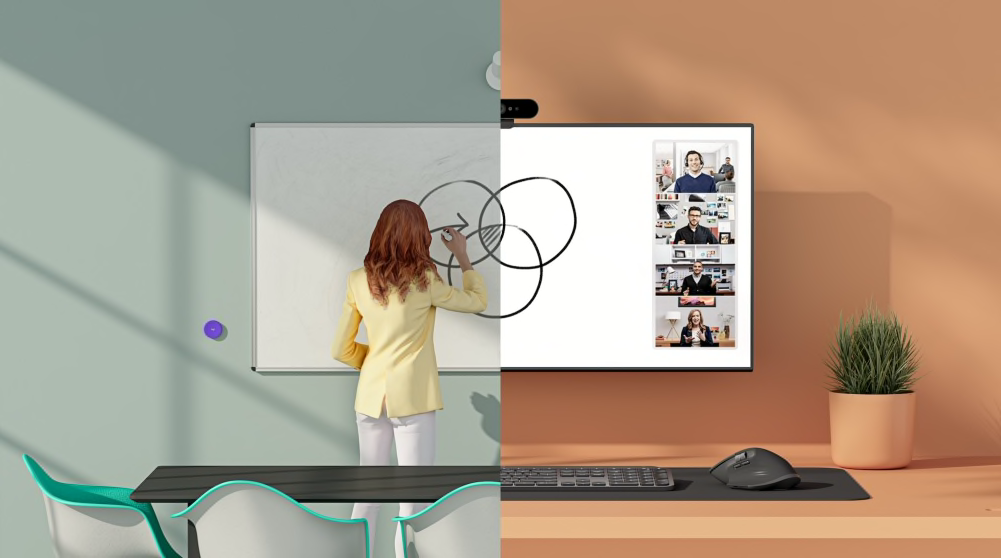How to Add Whiteboarding to Video Meetings
Enabling Virtual Team Collaboration in a Hybrid Workplace

Coming out of the pandemic, one thing is clear: employees will continue to work remotely and virtual teams will remain the norm. The resulting “hybrid workplace” delivers numerous benefits, but it also raises questions around virtual collaboration. Whiteboards for example are a staple of team collaboration. But meeting organizers have had a difficult time incorporating this important tool in virtual team meetings. What’s the solution?
As traditional offices are replaced by hybrid workplaces and employees spend more time working remotely, virtual meetings will become the rule rather than the exception. According to Gartner, by 2024 only 25% of business meetings will take place in person, a drop from 60% prior to the pandemic.Gartner Says Worldwide End-User Spending on Cloud-Based Web Conferencing Solutions Will Grow Nearly 25% in 2020 But can employees work together as effectively in a hybrid model? Do they have all the tools they need for successful collaboration when working remotely? If not, what can IT organizations do to support virtual collaboration in a hybrid environment?
Why IT is Key to Enabling Collaboration in a Hybrid Workplace
For geographically dispersed teams, collaboration requires a more intentional effort—with the support of information technology. Cloud-based software like Google Workspace and Microsoft 365 is designed to facilitate collaboration. Video technology—webcams, conference cameras, and cloud video platforms like Zoom and Microsoft Teams—enables people to meet face-to-face, wherever they happen to be.
But there are gaps.
For example, executives have learned they can't rely solely on video conferencing and file-sharing, according to Forrester analyst Andrew Hewitt.Roberto Torres:Salesforce is adopting hybrid work. Here's how businesses can follow suit. Hewitt notes in particular that employees miss the ability to collaborate together using whiteboards, something that generally only happens in person.
Given the importance of whiteboards for collaboration, this is an issue IT leaders should be thinking about. Specifically, how do you bring whiteboards into virtual meetings to support a hybrid workforce?
The Role of Whiteboards in Collaboration
Whiteboards are ubiquitous in meetings because they clearly serve an important function, especially in brainstorming and ideation. Whiteboards are useful for diagramming, illustrating concepts, freeform note-taking, organizing thoughts with sticky notes, etc. These collaboration tools can take various forms, including dry-erase boards, whiteboard walls, even glass panes.
In meetings, people often use presentations, spreadsheets, and other documents to share information and lead discussions. Hence, the popularity of Google Workspace and Microsoft 365. However, these tools are not suited for group brainstorming, especially when teams need to spontaneously explore concepts or visualize designs.
When people want to communicate visually, they often reach for a dry erase marker. And everyone’s attention turns to the whiteboard. In virtual meetings, however, this can be a problem.
Challenges with Virtual Whiteboarding
Lacking an elegant way to bring the whiteboard into a video meeting, people have tried various approaches. For example, a meeting organizer may point the conference camera at the whiteboard. But this seldom works well. The person writing on the whiteboard will likely block part of the view. Even when that person steps out of the frame, the whiteboard can be hard to read because of glare or a skewed perspective.
Sometimes a person in the room will take photos of the whiteboard and send the photos to everyone in the meeting. At best, that’s a minimally effective way to capture notes and it doesn’t enable remote participants to actively participate in what’s happening on the whiteboard.
In the end, people who are not in the room tend to feel left out whenever a whiteboard is used in a video meeting. As a result, their input and opinions, while valuable, are not part of the brainstorming session. It doesn’t have to be that way.
Ensuring Everyone Has a Seat at the Table
In a hybrid model, organizations need to ensure remote employees have access to the same information that in-office employees do.Hybrid-Remote: understanding nuances and pitfalls Successful collaboration depends on the ability of people to share ideas. A diversity of opinions and perspectives is helpful, even necessary. Everyone’s voice should be heard.
The goal of virtual collaboration should therefore be to ensure everyone in the meeting is an active participant in the process. IT can play a valuable role here. By enabling or improving collaboration in a hybrid workspace, IT can take steps to “democratize” the meeting experience, including:
- Redesigning digital and physical workspaces so remote workers do not feel like “second-class members of the workforce".Stefan Hammond: Hybrid Working Needs More Than Digital Enablement
- Equipping all meeting spaces for collaboration by providing video conferencing equipment; room solutions like Microsoft Teams Rooms, Zoom Rooms, or Google Meet; dry erase whiteboards; and specially designed whiteboard cameras.
With the lessons learned from remote working, executives and employees are touting the benefits of the hybrid workplace. But to ensure these benefits continue to accrue, organizations will need to follow through on their plans to invest in tools for virtual collaboration (like Logitech Scribe). If they do, both organizations and employees will reap the rewards.
YOU MAY ALSO BE INTERESTED IN
Browse Categories: